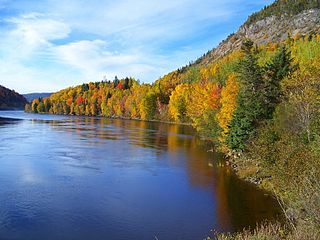This page is based on this
Wikipedia article Text is available under the
CC BY-SA 4.0 license; additional terms may apply.
Images, videos and audio are available under their respective licenses.

Cape Spear, located on the Avalon Peninsula near St. John's, Newfoundland, is the easternmost point in Canada (52°37'W), and North America, excluding Danish-controlled Greenland.

Channel-Port aux Basques is a town at the extreme southwestern tip of Newfoundland fronting on the western end of the Cabot Strait. A Marine Atlantic ferry terminal is located in the town which is the primary entry point onto the island of Newfoundland and the western terminus of the Trans-Canada Highway in the province. The town was incorporated in 1945 and its population in the 2011 census was 4,170.

SS Southern Cross was a steam-powered sealing vessel that operated primarily in Norway and Newfoundland and Labrador.

Cape Ray is a headland located at the southwestern extremity of the island of Newfoundland in the Canadian province of Newfoundland and Labrador.

Cape Norman is a barren, limestone headland located at the northernmost point of insular Newfoundland in the Canadian province of Newfoundland and Labrador.

Cape Anguille is a headland and the westernmost point in Newfoundland, reaching into the Gulf of Saint Lawrence. It is the southern edge of St. George's Bay. Its name is derived from the nearby Cape Anguille community.
Portugal Cove South is a small fishing town on the southern shore of the Avalon Peninsula of Newfoundland in the province of Newfoundland and Labrador, Canada. It is located 138 km south of St. John's.

The headland of Cape St. Mary's is located at the southern tip of the south-western arm of the Avalon Peninsula of the island of Newfoundland in the Canadian province of Newfoundland and Labrador.
A headland is a coastal landform, a point of land usually high and often with a sheer drop, that extends into a body of water. It is a type of promontory. A headland of considerable size often is called a cape. Headlands are characterised by high, breaking waves, rocky shores, intense erosion, and steep sea cliffs.

Newfoundland is a large Canadian island off the east coast of the North American mainland, and the most populous part of the Canadian province of Newfoundland and Labrador. It has 29 percent of the province's land area. The island is separated from the Labrador Peninsula by the Strait of Belle Isle and from Cape Breton Island by the Cabot Strait. It blocks the mouth of the Saint Lawrence River, creating the Gulf of Saint Lawrence, the world's largest estuary. Newfoundland's nearest neighbour is the French overseas community of Saint-Pierre and Miquelon.

Mistaken Point Ecological Reserve is a wilderness area and a UNESCO World Heritage Site (2016) located at the southeastern tip of the Avalon Peninsula in Newfoundland and Labrador, Canada which contains the Mistaken Point Formation, the site of Ediacaran fossils representing the oldest multicellular life on Earth.
The reserve contains one of the most diverse and well-preserved collections of Precambrian fossils known. In order to view these fossils, visitors must either reserve a guided tour with Natural Areas staff or obtain a permit issued by the Government of Newfoundland & Labrador. For more information about visiting the site, see the Government of Newfoundland & Labrador website via the following link https://www.flr.gov.nl.ca/natural_areas/wer/r_mpe/.

Cape Bonavista Light is a lighthouse located on Cape Bonavista, Newfoundland. The lighthouse, which operated from 1843 until 1962, is now a provincial museum, containing an exhibition about life in a lighthouse during the 1870s.

The Cape North Lighthouse is a cylindrical lighthouse tower with a red and white checkerboard pattern that stood at Money Point, near Cape North, Cape Breton from 1908 to 1980. While originally installed at Cape Race, Newfoundland, this tower is most commonly referred to as the Cape North Lighthouse. It now stands landlocked at the Canada Science and Technology Museum in Ottawa, Ontario, Canada.

NunatuKavut is an unrecognized Inuit territory in Labrador. The NunatuKavut people are the direct descendants of the Inuit that lived south of the Churchill or Grand River prior to European contact, with European influence from Basque and French whalers.

Cape Pine Light was built on Cape Pine, Newfoundland by the British architect and engineer Alexander Gordon in 1851.














